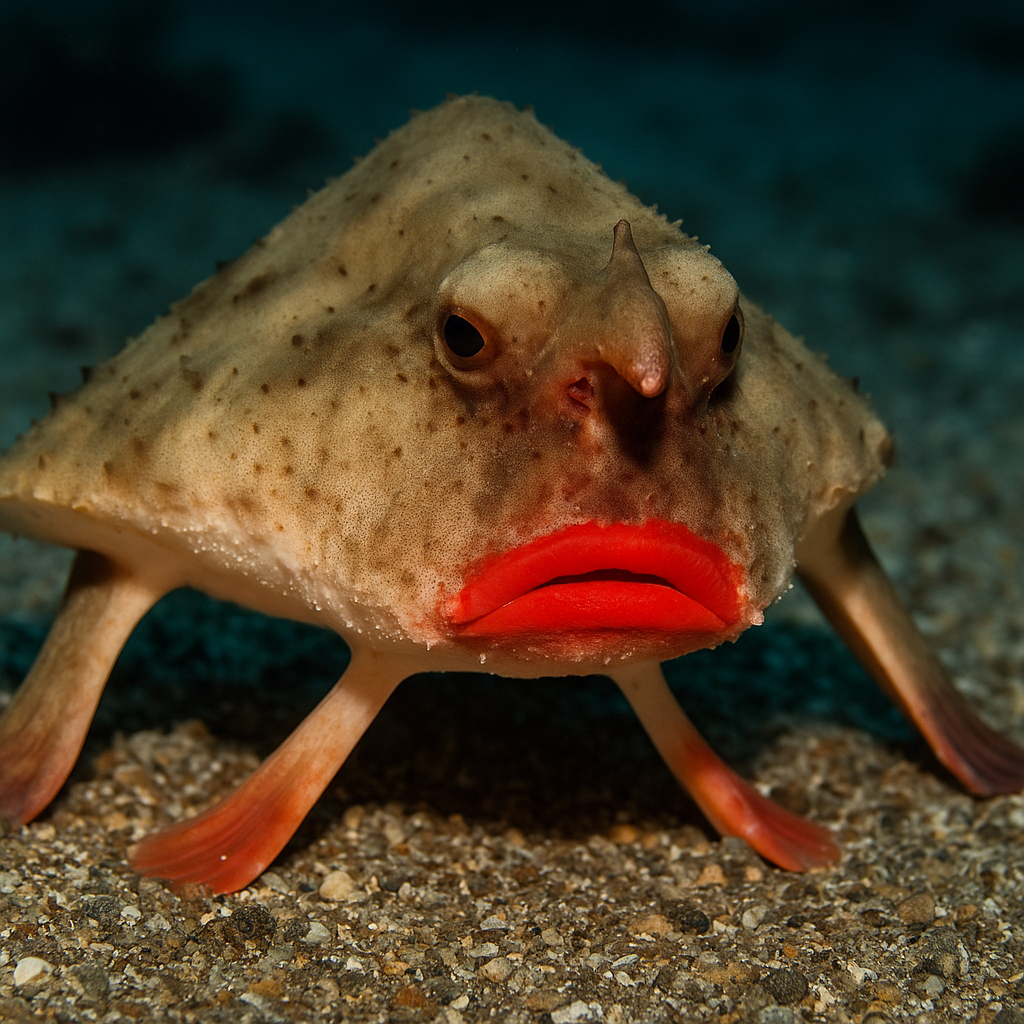The Red-Lipped Batfish: A Fascinating Creature of the Deep Ocean
The Red-Lipped Batfish (Ogcocephalus darwini) is one of the most distinctive and unusual creatures found beneath the ocean’s surface. With its striking appearance and quirky behavior, this fish has captured the curiosity of marine biologists and nature enthusiasts alike. In this article, we will explore the unique characteristics, habitat, diet, and conservation status of the Red-Lipped Batfish, shedding light on why this creature is so fascinating.

What is a Red-Lipped Batfish?
The Red-Lipped Batfish is a species of batfish known for its bright red, pouty lips that resemble the exaggerated lip shape commonly seen in caricatures. This feature, combined with its flat, bat-like body and ability to “walk” along the ocean floor, makes the Red-Lipped Batfish an unforgettable sight. Native to the waters surrounding the Galápagos Islands, this fish is an excellent example of how adaptation and evolution can lead to the development of strange yet effective traits in the animal kingdom.
Physical Characteristics of the Red-Lipped Batfish
The most obvious characteristic of the Red-Lipped Batfish is its vibrant red lips. The lips’ bold coloration contrasts sharply with the fish’s pale body, making it stand out in the otherwise drab underwater world. However, it is not just its lips that are unique. The Red-Lipped Batfish has a flattened body that allows it to rest comfortably on the ocean floor. It also possesses modified pectoral fins, which function like legs. These fins are used to “walk” along the seabed, propelling the fish forward in a manner similar to a land-dwelling animal.
Despite its aquatic nature, the Red-Lipped Batfish is a poor swimmer and relies heavily on its ability to move across the sea floor. Its walking ability is a form of locomotion adapted to its lifestyle in the shallow, rocky regions of the Galápagos Islands, where it spends most of its time.
Habitat and Distribution
The Red-Lipped Batfish is native to the waters surrounding the Galápagos Islands, an archipelago located in the Pacific Ocean, approximately 600 miles off the coast of Ecuador. The Galápagos Islands are known for their unique biodiversity and have served as the inspiration for Charles Darwin’s theory of evolution. The Red-Lipped Batfish is typically found in shallow waters at depths of 10 to 20 meters (33 to 66 feet), often in areas with rocky or sandy substrates.
The Galápagos Islands provide an ideal environment for the Red-Lipped Batfish due to their isolation and the variety of marine ecosystems they support. The relatively warm and nutrient-rich waters provide the perfect conditions for the Red-Lipped Batfish to thrive, although its population density is relatively low, making sightings of this creature a rare treat for divers and marine researchers.
Behavior and Diet
Unlike many other fish species that swim freely through the water, the Red-Lipped Batfish is more of a bottom-dweller. It spends much of its time walking across the ocean floor in search of food. The fish uses its modified pectoral fins to “walk” and can move in a series of short bursts. It also has a lure-like appendage on its chin, similar to the anglerfish, which is used to attract prey, such as small fish and invertebrates.
The diet of the Red-Lipped Batfish primarily consists of small fish, crustaceans, and other marine invertebrates. By using its walking ability and its unique lure, it effectively hunts in the rocky, sandy seafloor habitats of the Galápagos Islands. The Red-Lipped Batfish does not rely on speed or agility to catch prey; instead, it uses a combination of stealth and its fascinating, lure-based hunting technique.
Reproduction and Lifespan
Like many deep-sea creatures, the reproduction process of the Red-Lipped Batfish remains largely a mystery, primarily because of the species’ elusive nature and the difficulty of studying it in the wild. However, it is known that the Red-Lipped Batfish is a relatively slow breeder. It lays eggs, and like many fish species, the larvae eventually develop into juvenile fish that resemble miniature versions of the adults.
As for its lifespan, the Red-Lipped Batfish typically lives for several years in the wild, although precise figures are difficult to establish. Its isolation in the Galápagos Islands and its specialized lifestyle may contribute to its longevity, as it faces fewer natural predators in its unique habitat.
Conservation Status
Currently, the Red-Lipped Batfish is not listed as an endangered species, but its population is limited to a relatively small geographic area around the Galápagos Islands. As such, the fish is vulnerable to changes in its environment, including pollution, climate change, and habitat destruction. The Galápagos Islands are a UNESCO World Heritage Site and are heavily protected, which helps ensure the survival of the Red-Lipped Batfish and other endemic species in the region.
However, like many marine species, the Red-Lipped Batfish faces potential threats from human activities, such as overfishing and the impacts of climate change. It is essential to maintain conservation efforts in the Galápagos Islands to safeguard the delicate ecosystems in which the Red-Lipped Batfish lives.
Conclusion: Why the Red-Lipped Batfish Matters
The Red-Lipped Batfish may not be the most graceful swimmer, but it is one of the most fascinating creatures in the underwater world. Its vibrant red lips, bat-like appearance, and unique walking ability make it an iconic symbol of the Galápagos Islands’ biodiversity. While its population remains stable for now, it is important to continue supporting conservation efforts to protect the natural habitats of this quirky fish and the many other extraordinary species that call the Galápagos Islands home.
By learning more about this extraordinary creature, we can appreciate the diversity of life on Earth and the incredible adaptations that enable animals like the Red-Lipped Batfish to survive and thrive in some of the most unique environments on the planet.








